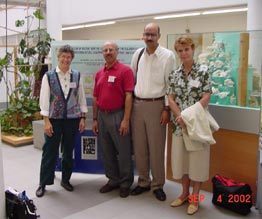Trekking Through Europe
Paul Bunje actually spent most of this past year spent in Munich,
Germany doing research into the phylogeography and evolutionary history
of a genus of European freshwater snails. Based at the Zoologische Staatssammlung
München, Paul was able to travel to such places as Ukraine, Hungary,
Italy, Austria, Israel, and throughout Germany to collect different populations
and species of the genus Theodoxus. The pattern of population-level
integration among these living snails will continue to be analyzed in
the Molecular Phylogenetics Laboratory of UCMP. These patterns, along
with analysis of fossil populations from Israel and phylogenetic data,
should help to shed light on the patterns of gene flow, which influence
diversification of both species and their morphologies.
 Kevin Padian spent the first five weeks of the summer in Paris
as an Invited Professor in the College de France, giving a series of
lectures on Paleontology, Evolution, and the History of Science. This
also provided him the opportunity to work on manuscripts with French
colleagues, Armand de Ricqlès and Philippe Taquet, on the histology
of Triassic archosaurs and on the earliest reconstruction of a pterosaur.
Kevin also spent a month in Germany at the Staatliches Museum fur Naturkunde
in Stuttgart, working with Rupert Wild on Early Jurassic pterosaurs. Kevin Padian spent the first five weeks of the summer in Paris
as an Invited Professor in the College de France, giving a series of
lectures on Paleontology, Evolution, and the History of Science. This
also provided him the opportunity to work on manuscripts with French
colleagues, Armand de Ricqlès and Philippe Taquet, on the histology
of Triassic archosaurs and on the earliest reconstruction of a pterosaur.
Kevin also spent a month in Germany at the Staatliches Museum fur Naturkunde
in Stuttgart, working with Rupert Wild on Early Jurassic pterosaurs.
 Mary McGann attended the Third International Congress of the
International Society of Environmental Micropaleontology, Microbiology,
and Meiobenthology in Vienna, Austria, September 16, 2002. The conference
was attended by 140 participants from 40 countries and covered diverse
topics such as the application of foraminifers, diatoms, pollen, molluscs,
worms, and bacteria to pollution and climate issues. As a member of
the Board of Directors of ISEMMM, Mary co-edited the abstract
volume, acted as a session chair, Mary McGann attended the Third International Congress of the
International Society of Environmental Micropaleontology, Microbiology,
and Meiobenthology in Vienna, Austria, September 16, 2002. The conference
was attended by 140 participants from 40 countries and covered diverse
topics such as the application of foraminifers, diatoms, pollen, molluscs,
worms, and bacteria to pollution and climate issues. As a member of
the Board of Directors of ISEMMM, Mary co-edited the abstract
volume, acted as a session chair,
|
|

Mary McGann (left), Lipps’ Lab, with other attendees at the September ISEMMM conference in Vienna, Austria.
and presented the conference wrap-up
as well as a talk about microfossil evidence (forams and isotopes) of
the Medieval Warm Period in estuarine deposits of San Francisco Bay.
The next congress will be held in Turkey in 2006.
Rediscovering Nevada’s Woods
For many, writer Nell Murbarger’s assessment of Nevada’s Smoke Creek
Desert as a “terrible vastness, lonely and barren and as dry as mummy
dust,” describes much of the state. However, a group of forest biologists
and a couple of paleobotanists see Nevada differently. In the past,
Nevada had numerous large lakes teeming with fish and surrounded by
diverse conifer-hardwood forests rivaling those of the eastern U.S.—big
trees and yes, lots of shade.

|
